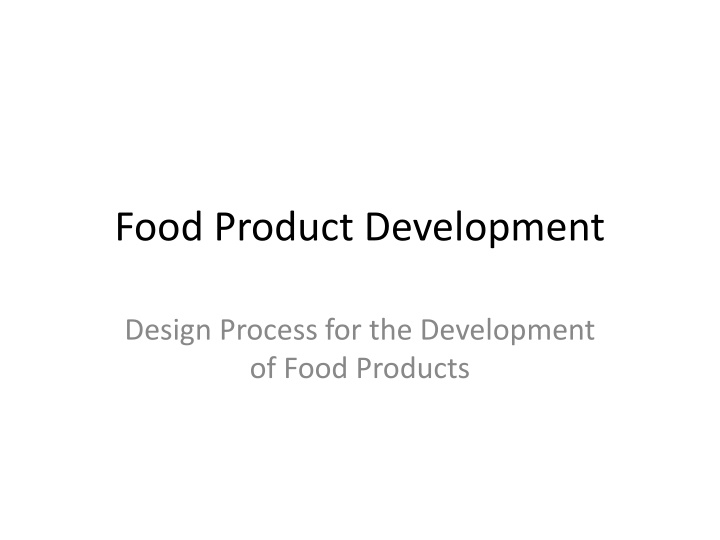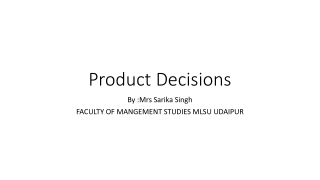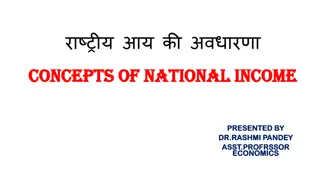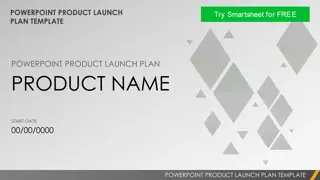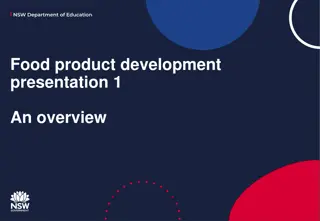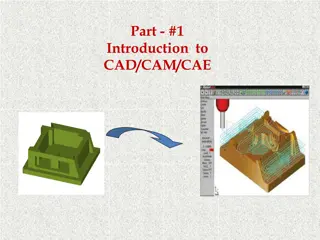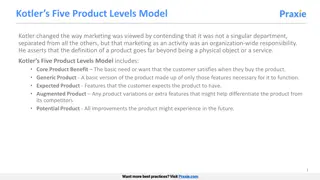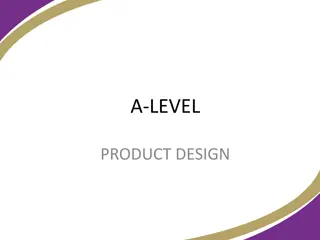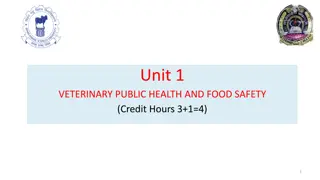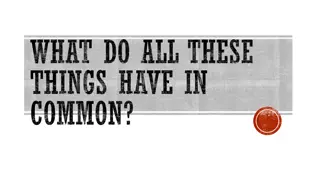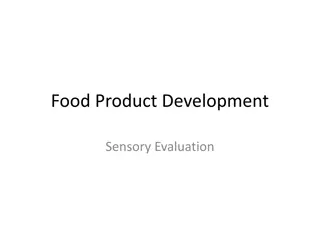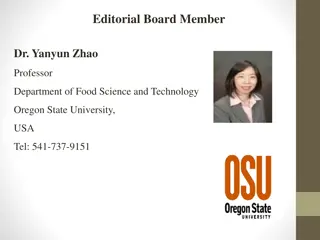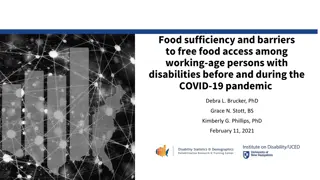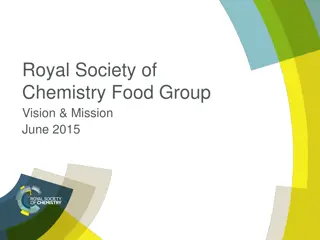Food Product Development Design Process
Phases and strategies involved in food product development, from market research to prototype creation and evaluation. Learn about the key steps such as idea generation, feasibility study, and design specification to bring a new food product to the market successfully.
Download Presentation

Please find below an Image/Link to download the presentation.
The content on the website is provided AS IS for your information and personal use only. It may not be sold, licensed, or shared on other websites without obtaining consent from the author.If you encounter any issues during the download, it is possible that the publisher has removed the file from their server.
You are allowed to download the files provided on this website for personal or commercial use, subject to the condition that they are used lawfully. All files are the property of their respective owners.
The content on the website is provided AS IS for your information and personal use only. It may not be sold, licensed, or shared on other websites without obtaining consent from the author.
E N D
Presentation Transcript
Food Product Development Design Process for the Development of Food Products
Topics Introduction Design brief Market research Design specification Idea generation Feasibility study Development of prototype Evaluation of a food product / design idea 2
Introduction Product Development: The overall process of strategy, organisation, concept generation, product and marketing plan creation and evaluation, and commercialisation of a new product. The Product Development and Management Association The PDMA Hand Book 1st Edition. 4
Phases in Product Development New food product development can be divided into several phases There is no common agreement on the number, order, or names of the phases Practically, the phases overlap and are concurrent 5
Phases in Product Development Earle (2009) describes the development process with four main stages: Stage 1 Development of a business strategy that describes the project Stage 2 A research and development phase of the project including the design for manufacturing process Stage 3 Development of programmes for marketing, production, and quality assurance Stage 4 Organisation of production and distribution for the launch and an analysis of the launch sales data 6
Design Process Evaluation of a food product / design idea Development of prototype Feasibility study Design specification Market research Idea generation Design brief Identify design problems Collect and analyse information of customers needs Devise the intended purpose of a product Study the internal and external factors Evaluation or analysis of the possible potentials of the proposed food product idea Make the first real product as a specimen for trial and market research Evaluation of a prototype sensory evaluation Identify user group Issues affecting the development of a new product Generating design proposals Modifying food products 7
Identifying Design Problems Identify a gap in the current market to see if there is a need of a new product that will satisfy customers need Identify a user group or target market 9
Ways to Identify the Gap in the Market Looking at what competitors are producing Reading newspaper and magazine articles Reading recipe books Looking at what products already exist and thinking how a new range could be developed Looking at trends in the media Identifying the gap Carrying out interviews and questionnaires Consulting government research Carrying out supermarket surveys 10
Examples of Gaps in the Market From a manufacturer s research, it is seen that snacks are mainly youthful and fun or mature and healthy. A need of youthful and healthy snacks is lacking. After looking at what is available in other supermarkets, a food retailer has decided that their range of single portion cook-chill meals needs developing. A food retailer has decided to reflect the 2 plus 3 a Day campaign by introducing a new range of fruit desserts. Summer desserts are selling well, a food retailer wants to develop their range. 11
Identifying the User Group or Intended Target Market The purpose is to match the product to customers need, hence satisfying customer by producing a successful marketable product The user group or intended target market is the group of people whom a product is aimed at 12
Identifying the User Group or Intended Target Market Vegetarians Parents Teenagers Examples of user group or intended target market Couples Toddlers Single- person household Elderly 13
Identifying the User Group or Intended Target Market Reasons for identifying the customers Views of the group are considered Dietary needs can be taken into account Eating habits are considered Preferred cooking method, e.g. microwavable dinners for college students Appropriate portion size Packaging and marketing of the product is focused towards the user group Cost is appropriate for the targeted customers 14
Developing a Design Brief A design brief is a short statement that outlines the problem to be solved. The design brief may state: - the product must be marketable - the type of product to be developed - the user group or intended target market - the occasion or place which the product is used / consumed - the cost A design brief is a short statement that outlines the problem to be solved. 15
Developing a Design Brief Example of a design brief: Design and make a marketable hand-held savoury snack for vegetarian adults at a cost of HK$10. 16
Purpose of Conducting Research To find out the opinions of the intended target market To ensure time and money are not wasted on a product no one will want To find out about types of products which are already in the market Why carry out research? To find out market trends e.g. shopping/eating habits To find out which products are marketable using sales figures 18
Market Research A process of collecting and analysing information of customers needs Helps a company to create its business plan and to find out if the new product is marketable Can be done by research companies Two types of market research: primary research and secondary research 19
Two Types of Market Research Primary research sources Secondary research sources Information that is obtained directly from interviews, questionnaires and observations or from sensory testing Information that has been collected by other people, for instance, from books or newspapers 20
Two Types of Market Research Primary research Secondary research Source of information Focus groups, surveys, field tests, interviews or observation Local libraries, web sites, books, business publications, magazines and newspapers Purpose Gain information from a company s target group of customers for a particular new products Find out market information for extending business into new markets, adding new services or product lines Accuracy and specificity Tailor-made for the company s particular needs More accurate and specific for the target market of the company Second-hand information, less accurate, useful and specific, which may not suit the particular need of the company Expense More expensive Less expensive Source: Food Science and Technology Strand (n.d.). Learning and Teaching References, Technology and Living (Secondary 4-6), 13 Food Product Development. Hong Kong Education Bureau. 21
Methods of Research 1. Questionnaires A set of questions carefully designed to obtain the opinions of people Can be done by research companies Can be carried out in a variety of ways, e.g.: - over the telephone - in supermarket - sent through the post - on the street 22
Methods of Research 2. Evaluating existing products A food manufacturer may evaluate their own existing products or those of their competitors Can be done by carrying out sensory evaluation Reasons for evaluating existing products: - to get ideas for new products - to improve existing products sensory evaluation: looking at, smelling and tasting a food for product development. 23
Methods of Research 3. Supermarket surveys Visits to supermarkets are useful to find out: - what products competitors are producing and selling - the costs of similar products - how well a product is selling - information about the market trends, e.g. eating and shopping habits of people 24
Questionnaires A questionnaire should be designed for extracting specific information from people about the qualities they would like to see in a new product Properly introduce the questionnaire, so that it allows the public to: - focus clearly on the theme of the questionnaire - feel involved from the start, so a more satisfactory response is given - understand the purpose of the questionnaire Fehners, V., Simpson, M., & Monks, B. (2011). Food technology. London: Hodder Education. 25
Questionnaires General rules of designing questionnaires: Questions are clear and easy to understand and answer Easy to collate the results using graphs, tables, tally charts, pie charts, etc. Data are easy to analyse and draw conclusion from Questionnaire should not be too long that may cause irritation Make sure that all questions will lead to useful answers Information and Communication Technology (ICT) is often used to design and analyse the questionnaire After obtaining results, summarise the findings Fehners, V., Simpson, M., & Monks, B. (2011). Food technology. London: Hodder Education. 26
Questionnaires Different types of questions can be used: 1. Closed questions can be a very quick way of finding out specific information provide a yes/no type response or offer limited choice of answers, e.g. Do you like the flavour of the chocolate? Yes No Fehners, V., Simpson, M., & Monks, B. (2011). Food technology. London: Hodder Education. 27
Questionnaires 2. Multiple choice offers a range of responses for the respondents to choose from, e.g. Which flavour do you prefer? Chocolate Lemon Coffee Ginger Fehners, V., Simpson, M., & Monks, B. (2011). Food technology. London: Hodder Education. 28
Questionnaires 3. Ordered choice sometimes it is useful for the respondents to rank a set of options by numbering them in order, e.g. Place in order of preference the following flavourings. Indicate by numbering from 1 to 4 in order, where 1 is the most preferred. Chocolate Lemon Coffee Ginger Fehners, V., Simpson, M., & Monks, B. (2011). Food technology. London: Hodder Education. 29
Questionnaires 4. Open-ended questions can produce a wide variety of responses that take a long time to interpret and put into categories useful for finding out about attitudes and opinions, e.g. 1. What do you like about biscuits? 2. What flavour would you like the biscuit to be and why? Fehners, V., Simpson, M., & Monks, B. (2011). Food technology. London: Hodder Education. 30
The Intended Purpose of a Product The product development team is a group of people who are responsible for creating new food products. The product development team should have a clear understanding of the product s intended purpose Examples: - The intended purpose of a cereal bar is to provide a quick, hand-held and easy to eat snack. - The intended purpose of a single frozen meal is to provide a quick and convenient meal for one person. 32
Issues Affecting the Development of a New Product Consider the issues that might affect product development, e.g.: 1. Method of production 2. Environmental issues 3. Cost issues 4. Ethical issues 5. Social issues 6. Cultural issues 33
Issues Affecting the Development of a New Product Can be manufactured with existing machinery? Budget for buying and installing new machinery? Method of production Environmental issues Packaging materials include recycled or recyclable materials? Budget available to produce the new product? Consider food cost, production cost, distribution cost, and profit Cost issues Ethical issues Do the products include any genetically modified foods? Is there demographic differences in different areas? E.g. retailers in a wealthy district make more profits on expensive items. Social issues Are the ingredients in the products suitable for all cultures, including different religions? Cultural issues 34
Writing a Design Specification A design specification is usually written as a series of bullet points or a numbered list. It clearly states the general details of the product to be developed. It is a checklist for evaluation throughout the development of a product and when testing the final product. Design specification: the qualities a product should have. 35
Writing a Design Specification A design specification may include the following: Type and purpose of product Requirements of target group Nutritional information Types of ingredients to be used Portion size Shape / Flavour / Colour Price range of the product Packaging Storage and shelf life considerations Environmental / Ethical / Social / Cultural issues 36
Writing a Design Specification Example of a design specification: Low-fat, less than 3g per 100g portion Hand-held Savoury Priced between HK$10 and HK$15 Use existing packaging materials Design specification Snack size Tasty Suitable for manufacture in quantity 37
Idea Generation A process of creating ideas or concepts for developing new products; also called concept generation By studying external and internal factors as well as the trends of the marketplace, find out ways of either improving or modifying the current products Source: Food Science and Technology Strand (n.d.). Learning and Teaching References, Technology and Living (Secondary 4-6), 13 Food Product Development. Hong Kong Education Bureau. 39
Idea Generation Recipe books Web sites Existing products Where do ideas come from? Ideas from chefs on the television Analysis of research information 40
Idea Generation Can be done by brainstorming or mind map Brainstorming A useful tool for generating ideas A problem solving activity by a group of people trying to find out a solution to a specific problem Source: Food Science and Technology Strand (n.d.). Learning and Teaching References, Technology and Living (Secondary 4-6), 13 Food Product Development. Hong Kong Education Bureau. 41
Idea Generation Mind map A diagram used to note down words, ideas, tasks or other items linked to and arranged radially around a central key word or idea A useful tool in the process of brainstorming The schematic structure of information may aid the recall of existing memories Source: Food Science and Technology Strand (n.d.). Learning and Teaching References, Technology and Living (Secondary 4-6), 13 Food Product Development. Hong Kong Education Bureau. 42
Idea Generation Use sweeteners available in Example of a mind map: food law to replace sugar block the esophagus Suitable, not easy to Different flavours Floral flavours Candy Low sugar Safe to eat Healthy for elderly Source: Food Science and Technology Strand (n.d.). Learning and Teaching References, Technology and Living (Secondary 4-6), 13 Food Product Development. Hong Kong Education Bureau. 43
Generating Design Proposals A product development team communicates their ideas to other people by: - annotated sketches - mood boards - photographs - making up samples 44
Annotated sketches What could an annotated sketch include? Size/Weight Shape Ingredients to be used Finishes Colours Method of production Nutritional information Packaging (optional) 45
Feasibility Study An evaluation or analysis of the possible potentials of the proposed food product idea Provides information to assist decision-makers to determine whether the idea is feasible or the development process has to be stopped at this stage Based on an extensive research and analysis on financial and operational impact 48
Feasibility Study Can the product be produced by existing facilities? Questions to be Answered During a Feasibility Study Are new facilities needed? Does the manufacturing process have to be invented for the new product? If yes, consider extra resources. Are the required raw and packaging materials available? Are there any other operational considerations particular to the project? What is the capital of the project? Is the price acceptable by the customers? Is the selling price of the product competitive enough? 49
